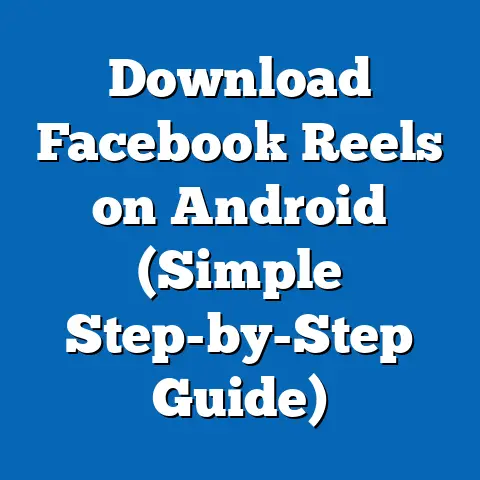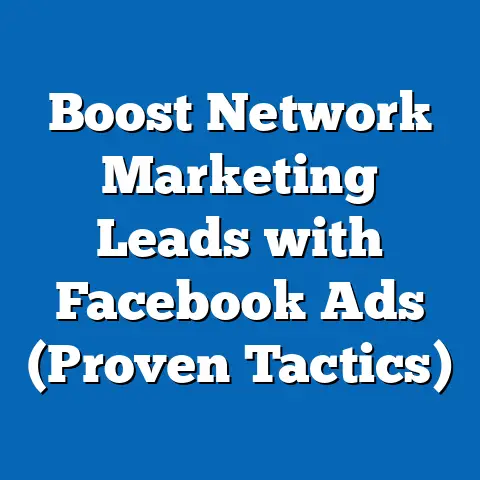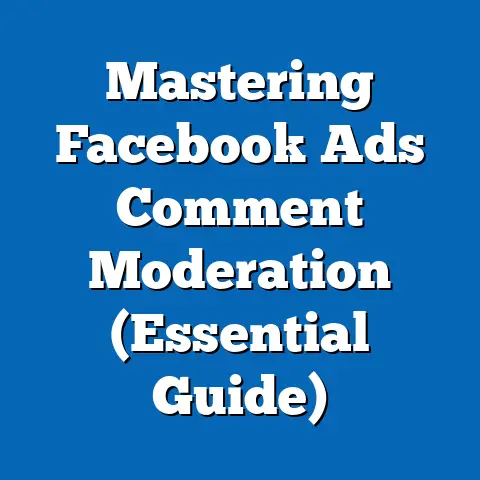Unlocking Real Estate Sales with Facebook Ads (Pro Strategies)
The world of real estate is a whirlwind. I’ve seen it firsthand – the excited chatter at open houses, the nervous anticipation of first-time buyers, and the sheer beauty of finding someone their dream home. It’s a fast-paced, competitive industry where every edge counts. And in today’s digital age, that edge often comes down to one thing: effective online marketing. While traditional methods still hold their place, I believe Facebook ads have revolutionized how real estate agents connect with potential clients. It’s not just about posting listings; it’s about strategically targeting the right people, with the right message, at the right time. Facebook’s granular targeting capabilities allow us to pinpoint demographics, interests, and behaviors, making it a powerful tool for generating leads and driving sales in the real estate market. Let’s dive into how you can unlock the full potential of Facebook ads to transform your real estate business.
Understanding Facebook Ads
Facebook ads are more than just digital billboards. They are a dynamic and versatile tool that allows you to reach a specific audience with tailored messages. Think of them as personalized invitations to explore your real estate offerings.
There’s a diverse range of ad formats available, each with its unique strengths:
- Carousel Ads: Showcase multiple properties or highlight different features of a single listing.
- Video Ads: Offer virtual tours, agent introductions, or community spotlights to create an immersive experience.
- Image Ads: Use high-quality photos to capture attention and spark interest in a property.
- Slideshow Ads: Combine multiple images with text and music to tell a compelling story.
- Lead Ads: Collect contact information directly from potential clients without them having to leave Facebook.
I’ve found that the beauty of Facebook ads lies in their ability to surpass the limitations of traditional advertising. Unlike newspaper ads or flyers, which reach a broad and often untargeted audience, Facebook ads allow you to pinpoint your ideal client based on demographics, interests, and even online behaviors. Imagine showing your luxury home listing only to individuals with a high net worth who have expressed interest in upscale properties – that’s the power of Facebook’s targeting capabilities.
Takeaway: Facebook ads offer a targeted and versatile approach to reaching potential real estate clients, surpassing the limitations of traditional advertising methods.
Setting Up Your Facebook Ads Campaign
Creating a successful Facebook ads campaign for real estate involves a strategic approach, starting with a clear understanding of your objectives and target audience. I always advise my clients to begin with the end in mind. What do you want to achieve with your campaign? Are you looking to generate leads, increase brand awareness, or drive traffic to your website? Defining your objective will guide every decision you make along the way.
Here’s a step-by-step breakdown of setting up an effective Facebook ads campaign:
-
Define Your Campaign Objective: Choose an objective that aligns with your overall marketing goals. Common objectives for real estate include lead generation, website traffic, brand awareness, and engagement.
-
Research and Define Your Target Market: This is where Facebook’s targeting capabilities truly shine. Consider factors like age, location, income, education, interests, and online behaviors. Are you targeting first-time homebuyers, luxury property investors, or families looking to relocate? The more specific you are, the more effective your ads will be. I once ran a campaign targeting individuals who had recently changed their relationship status to “engaged” and were interested in home decor – it generated a significant number of leads from couples looking to buy their first home together.
-
Set Your Budget and Choose Ad Placements: Determine how much you’re willing to spend on your campaign and choose where you want your ads to appear. Facebook offers a variety of ad placements, including the news feed, stories, Instagram, and Audience Network. I’ve found that the news feed often performs best for real estate ads, as it allows for more detailed visuals and compelling copy.
-
Create Compelling Ad Copy and Visuals: Your ad copy should be clear, concise, and attention-grabbing. Highlight the key features and benefits of the property, and use strong calls-to-action to encourage potential clients to take the next step. High-quality images and videos are essential for showcasing the property in its best light. I always recommend using professional photography to create a visually stunning ad that captures the attention of your target audience.
Define Your Campaign Objective: Choose an objective that aligns with your overall marketing goals. Common objectives for real estate include lead generation, website traffic, brand awareness, and engagement.
Research and Define Your Target Market: This is where Facebook’s targeting capabilities truly shine. Consider factors like age, location, income, education, interests, and online behaviors. Are you targeting first-time homebuyers, luxury property investors, or families looking to relocate? The more specific you are, the more effective your ads will be. I once ran a campaign targeting individuals who had recently changed their relationship status to “engaged” and were interested in home decor – it generated a significant number of leads from couples looking to buy their first home together.
Set Your Budget and Choose Ad Placements: Determine how much you’re willing to spend on your campaign and choose where you want your ads to appear. Facebook offers a variety of ad placements, including the news feed, stories, Instagram, and Audience Network. I’ve found that the news feed often performs best for real estate ads, as it allows for more detailed visuals and compelling copy.
Create Compelling Ad Copy and Visuals: Your ad copy should be clear, concise, and attention-grabbing. Highlight the key features and benefits of the property, and use strong calls-to-action to encourage potential clients to take the next step. High-quality images and videos are essential for showcasing the property in its best light. I always recommend using professional photography to create a visually stunning ad that captures the attention of your target audience.
Takeaway: A well-defined campaign objective, a targeted audience, a strategic budget, and compelling creative are the cornerstones of a successful Facebook ads campaign for real estate.
Advanced Targeting Strategies
Once you’ve mastered the basics of Facebook ads, it’s time to delve into advanced targeting strategies that can significantly boost your campaign’s performance. I’ve seen firsthand how these techniques can transform a good campaign into a great one.
-
Custom Audiences: These allow you to target individuals who have already interacted with your business in some way. You can create Custom Audiences from your customer list, website visitors, app users, or even people who have engaged with your Facebook page. For example, you can upload a list of past clients and target them with ads promoting your services or new listings. I once created a Custom Audience of people who had visited the “luxury homes” section of my website and retargeted them with ads showcasing high-end properties – it resulted in a significant increase in inquiries and showings.
-
Lookalike Audiences: These are one of my favorite targeting tools. Lookalike Audiences allow you to reach new people who are similar to your existing customers or website visitors. Facebook analyzes the characteristics of your source audience (e.g., your customer list) and identifies other users who share similar demographics, interests, and behaviors. This is a great way to expand your reach and find potential clients who are likely to be interested in your real estate offerings. I often create Lookalike Audiences based on my top-performing Custom Audiences to reach a wider audience of qualified leads.
-
Retargeting Strategies: Retargeting involves showing ads to people who have previously interacted with your ads or website. This is a powerful way to re-engage potential clients who may have shown interest in your properties but haven’t yet taken the next step. You can retarget website visitors who viewed a specific listing, people who clicked on your ads but didn’t submit a lead form, or even individuals who abandoned their online property search. I’ve found that retargeting ads with a special offer or a compelling call-to-action can be highly effective in driving conversions.
-
Audience Segmentation: Not all real estate clients are the same. Segmenting your audience based on their specific needs and interests allows you to tailor your ads to resonate with them more effectively. For example, you can create separate campaigns for luxury homes, first-time buyers, and investment properties, each with its own unique targeting criteria and ad creative. I once ran a campaign targeting first-time buyers with ads emphasizing affordability and financing options, while simultaneously running a campaign targeting luxury property investors with ads highlighting potential ROI and high-end amenities.
Custom Audiences: These allow you to target individuals who have already interacted with your business in some way. You can create Custom Audiences from your customer list, website visitors, app users, or even people who have engaged with your Facebook page. For example, you can upload a list of past clients and target them with ads promoting your services or new listings. I once created a Custom Audience of people who had visited the “luxury homes” section of my website and retargeted them with ads showcasing high-end properties – it resulted in a significant increase in inquiries and showings.
Lookalike Audiences: These are one of my favorite targeting tools. Lookalike Audiences allow you to reach new people who are similar to your existing customers or website visitors. Facebook analyzes the characteristics of your source audience (e.g., your customer list) and identifies other users who share similar demographics, interests, and behaviors. This is a great way to expand your reach and find potential clients who are likely to be interested in your real estate offerings. I often create Lookalike Audiences based on my top-performing Custom Audiences to reach a wider audience of qualified leads.
Retargeting Strategies: Retargeting involves showing ads to people who have previously interacted with your ads or website. This is a powerful way to re-engage potential clients who may have shown interest in your properties but haven’t yet taken the next step. You can retarget website visitors who viewed a specific listing, people who clicked on your ads but didn’t submit a lead form, or even individuals who abandoned their online property search. I’ve found that retargeting ads with a special offer or a compelling call-to-action can be highly effective in driving conversions.
Audience Segmentation: Not all real estate clients are the same. Segmenting your audience based on their specific needs and interests allows you to tailor your ads to resonate with them more effectively. For example, you can create separate campaigns for luxury homes, first-time buyers, and investment properties, each with its own unique targeting criteria and ad creative. I once ran a campaign targeting first-time buyers with ads emphasizing affordability and financing options, while simultaneously running a campaign targeting luxury property investors with ads highlighting potential ROI and high-end amenities.
Takeaway: Advanced targeting strategies like Custom Audiences, Lookalike Audiences, retargeting, and audience segmentation can significantly improve the performance of your Facebook ads campaigns by reaching the right people with the right message.
Crafting High-Converting Ads
Creating high-converting Facebook ads for real estate is an art and a science. It requires a deep understanding of your target audience, a compelling message, and a visually appealing design. I’ve spent years perfecting this craft, and I’m excited to share some of my top tips with you.
-
Strong Call-to-Action (CTA): Your CTA is the most important element of your ad. It tells potential clients what you want them to do next. Use clear, concise, and action-oriented language that encourages them to take the desired step. Common CTAs for real estate ads include “Learn More,” “View Listing,” “Schedule a Showing,” and “Contact Us.” I always test different CTAs to see which ones generate the best results.
-
Storytelling Techniques: People are naturally drawn to stories. Use storytelling techniques to create an emotional connection with your audience and make your ads more memorable. Share stories of happy clients who found their dream homes, highlight the unique features and benefits of the property, or paint a picture of the lifestyle that potential buyers can enjoy. I once created a video ad that told the story of a young family who found their perfect home in a vibrant community – it resonated deeply with my target audience and generated a significant number of leads.
-
Testimonials and Social Proof: Building trust and credibility is essential for success in the real estate industry. Include testimonials from satisfied clients in your ads to showcase your expertise and positive reputation. Social proof, such as the number of homes you’ve sold or the awards you’ve won, can also help to build confidence in your services. I always include a client testimonial or a positive review in my ads to reassure potential clients that they’re making the right choice.
-
Successful Ad Campaign Examples: Let’s take a look at some examples of successful ad campaigns in the real estate sector:
-
Luxury Homes Campaign: A luxury real estate agent created a carousel ad showcasing stunning photos of a high-end property. The ad copy highlighted the unique amenities and features of the home, and the CTA was “Schedule a Private Showing.” The campaign targeted high-net-worth individuals who had expressed interest in luxury properties.
-
First-Time Buyers Campaign: A real estate broker created a video ad featuring a young couple who had recently purchased their first home with the broker’s assistance. The ad copy emphasized affordability, financing options, and the broker’s commitment to helping first-time buyers navigate the home-buying process. The campaign targeted individuals who had recently changed their relationship status to “engaged” or “married” and were interested in home decor.
-
Investment Properties Campaign: A real estate investor created a lead ad offering a free guide to investing in real estate. The ad copy highlighted the potential ROI and the benefits of investing in rental properties. The campaign targeted individuals who had expressed interest in finance, investing, and real estate.
-
Strong Call-to-Action (CTA): Your CTA is the most important element of your ad. It tells potential clients what you want them to do next. Use clear, concise, and action-oriented language that encourages them to take the desired step. Common CTAs for real estate ads include “Learn More,” “View Listing,” “Schedule a Showing,” and “Contact Us.” I always test different CTAs to see which ones generate the best results.
Storytelling Techniques: People are naturally drawn to stories. Use storytelling techniques to create an emotional connection with your audience and make your ads more memorable. Share stories of happy clients who found their dream homes, highlight the unique features and benefits of the property, or paint a picture of the lifestyle that potential buyers can enjoy. I once created a video ad that told the story of a young family who found their perfect home in a vibrant community – it resonated deeply with my target audience and generated a significant number of leads.
Testimonials and Social Proof: Building trust and credibility is essential for success in the real estate industry. Include testimonials from satisfied clients in your ads to showcase your expertise and positive reputation. Social proof, such as the number of homes you’ve sold or the awards you’ve won, can also help to build confidence in your services. I always include a client testimonial or a positive review in my ads to reassure potential clients that they’re making the right choice.
Successful Ad Campaign Examples: Let’s take a look at some examples of successful ad campaigns in the real estate sector:
-
Luxury Homes Campaign: A luxury real estate agent created a carousel ad showcasing stunning photos of a high-end property. The ad copy highlighted the unique amenities and features of the home, and the CTA was “Schedule a Private Showing.” The campaign targeted high-net-worth individuals who had expressed interest in luxury properties.
-
First-Time Buyers Campaign: A real estate broker created a video ad featuring a young couple who had recently purchased their first home with the broker’s assistance. The ad copy emphasized affordability, financing options, and the broker’s commitment to helping first-time buyers navigate the home-buying process. The campaign targeted individuals who had recently changed their relationship status to “engaged” or “married” and were interested in home decor.
-
Investment Properties Campaign: A real estate investor created a lead ad offering a free guide to investing in real estate. The ad copy highlighted the potential ROI and the benefits of investing in rental properties. The campaign targeted individuals who had expressed interest in finance, investing, and real estate.
Luxury Homes Campaign: A luxury real estate agent created a carousel ad showcasing stunning photos of a high-end property. The ad copy highlighted the unique amenities and features of the home, and the CTA was “Schedule a Private Showing.” The campaign targeted high-net-worth individuals who had expressed interest in luxury properties.
First-Time Buyers Campaign: A real estate broker created a video ad featuring a young couple who had recently purchased their first home with the broker’s assistance. The ad copy emphasized affordability, financing options, and the broker’s commitment to helping first-time buyers navigate the home-buying process. The campaign targeted individuals who had recently changed their relationship status to “engaged” or “married” and were interested in home decor.
Investment Properties Campaign: A real estate investor created a lead ad offering a free guide to investing in real estate. The ad copy highlighted the potential ROI and the benefits of investing in rental properties. The campaign targeted individuals who had expressed interest in finance, investing, and real estate.
Takeaway: Crafting high-converting Facebook ads for real estate requires a strong CTA, storytelling techniques, testimonials, and real-world examples to inspire and motivate potential clients.
Analyzing and Optimizing Your Campaign
Running a successful Facebook ads campaign is not a “set it and forget it” endeavor. It requires ongoing monitoring, analysis, and optimization to ensure that you’re getting the best possible results. I always tell my clients that data is your best friend in the world of online advertising.
-
Key Performance Indicators (KPIs): These are the metrics that you should monitor to gauge the success of your campaign. Common KPIs for real estate ads include:
- Click-Through Rate (CTR): The percentage of people who see your ad and click on it. A high CTR indicates that your ad is relevant and engaging to your target audience.
- Conversion Rate: The percentage of people who take the desired action after clicking on your ad (e.g., submitting a lead form, scheduling a showing). A high conversion rate indicates that your ad is effectively driving results.
- Cost Per Lead (CPL): The average cost of generating a lead through your Facebook ads. A low CPL indicates that your campaign is efficient and cost-effective.
-
A/B Testing: This involves testing different variations of your ads to see which ones perform best. You can A/B test different images, ad copy, CTAs, and targeting options. I always recommend testing one element at a time to isolate the impact of each change. For example, you can run two versions of your ad with different images to see which one generates a higher CTR.
-
Facebook Insights: This is a powerful tool that provides detailed data about your ad performance. You can use Facebook Insights to track your KPIs, analyze your audience demographics, and identify areas for improvement. I regularly review Facebook Insights to understand which ads are performing well and which ones need to be optimized.
-
Data-Driven Adjustments: Based on your analysis of the data, you can make adjustments to your campaign to improve performance. This may involve changing your targeting criteria, updating your ad copy, or adjusting your budget. I always recommend making data-driven decisions rather than relying on gut feelings.
Key Performance Indicators (KPIs): These are the metrics that you should monitor to gauge the success of your campaign. Common KPIs for real estate ads include:
- Click-Through Rate (CTR): The percentage of people who see your ad and click on it. A high CTR indicates that your ad is relevant and engaging to your target audience.
- Conversion Rate: The percentage of people who take the desired action after clicking on your ad (e.g., submitting a lead form, scheduling a showing). A high conversion rate indicates that your ad is effectively driving results.
- Cost Per Lead (CPL): The average cost of generating a lead through your Facebook ads. A low CPL indicates that your campaign is efficient and cost-effective.
A/B Testing: This involves testing different variations of your ads to see which ones perform best. You can A/B test different images, ad copy, CTAs, and targeting options. I always recommend testing one element at a time to isolate the impact of each change. For example, you can run two versions of your ad with different images to see which one generates a higher CTR.
Facebook Insights: This is a powerful tool that provides detailed data about your ad performance. You can use Facebook Insights to track your KPIs, analyze your audience demographics, and identify areas for improvement. I regularly review Facebook Insights to understand which ads are performing well and which ones need to be optimized.
Data-Driven Adjustments: Based on your analysis of the data, you can make adjustments to your campaign to improve performance. This may involve changing your targeting criteria, updating your ad copy, or adjusting your budget. I always recommend making data-driven decisions rather than relying on gut feelings.
Takeaway: Analyzing your campaign’s KPIs, conducting A/B testing, and leveraging Facebook Insights are crucial for optimizing your Facebook ads and maximizing your ROI.
Conclusion
Facebook ads have revolutionized the real estate industry, providing agents and brokers with a powerful tool to connect with potential clients and drive sales. By understanding the fundamentals of Facebook ads, implementing advanced targeting strategies, crafting high-converting ads, and continuously analyzing and optimizing your campaigns, you can unlock the full potential of this platform and achieve remarkable results.
I encourage you to embrace these professional strategies and integrate them into your marketing efforts. The competitive edge and increased sales that can come from effectively utilizing Facebook as a marketing platform are undeniable. Don’t be afraid to experiment, test different approaches, and learn from your successes and failures. With dedication, perseverance, and a data-driven mindset, you can master the art of Facebook advertising and transform your real estate business. So, take action today and start unlocking the power of Facebook ads to achieve greater success in the dynamic world of real estate!






